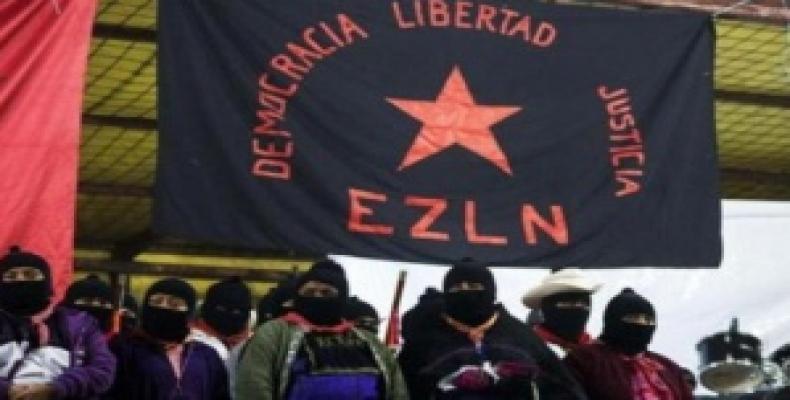Mexico City, January 3 (RHC)-- In Mexico, in the 25 years since the 1994 uprising, the National Liberation Zapatista Army has been a global reference for revolutionary movements.
“We’re the product of 500 years of struggles: first against slavery in the independence war led by insurgents against Spain, then avoiding being absorbed by North American expansionism, then for promulgating our Constitution and expelling the French Empire from our territory, then Porfirio’s dictatorship denied the fair implementation of the Reform Laws and the people stood up with its own leaders...”
Those were the opening lines of the first public statement by the National Liberation Zapatista Army (EZLN), published on the day of the uprising on January 1, 1994, when the North American Free Trade Agreement (NAFTA) came into effect. The agreement drove the United States, Canada and Mexico into a commercial zone that has since impoverished the working classes while making the bourgeoisie even richer.
In that first statement, the EZLN announced they would walk into Mexico City and defeat the national military, inviting people to rise up and join them in the fight. Since then, the Zapatistas have come an incredible distance, drawing various sectors of Mexican and international society, regardless of their background and skin color, into a struggle that continues today.
Their stance is different now. Perhaps the invitation to rise up in arms was a “bluff” to intimidate the government, but we will never know. In the early years, they negotiated the San Andres Accords with the federal government, establishing that Indigenous peoples’ autonomy would be respected. The agreements, however, were soon violated by the administration of Ernesto Zedillo Ponce de Leon, so the Zapatistas decided to implement them on their own, forever eschewing mainstream politics, including the new National Renewal Movement (Morena) led by Mexico's newly inaugurated President Andres Manuel Lopez Obrador.
Claudia T., one of the founding members of a collective named 'Mujeres y la Sexta,' was in Mexico City at the time of the uprising, 900 kilometers away from San Cristobal de las Casas. Sympathizers quickly organized protests to stop military action against the insurgents, and out of those connections were born new support networks in urban and rural areas. Some of those people formed brigades to bring aid to Chiapas, where the uprising took on new life. Luz y Fuerza del Centro, a state-owned electricity company with a combative union, even sent workers to install electricity in Zapatista villages where the government had been completely absent.
“There were several ways to help them. People from the pedagogy or nursing faculties used to go and support them,” Claudia told teleSUR. “We would rent a bus and go as far as we could, getting wet to reach the communities and help somehow. Everytime we went there we took more than we brought. They would offer us their love, their teachings, the humanism.”
Those were some of the first relations established between the insurgent group (or communities) and civil society living in the cities and towns outside of the Zapatista rebel territory. Through the years, collectives would establish long-standing relations with the Zapatistas, a network of organizations and sympathizers that has shaped the movement.
“Then the Sixth Declaration of the Selva Lacandona came. They explained their six points and asked us: What about you? We had to write our own points, how we thought we could change,” said Claudia.
“The relation established by going and supporting was transformed. It was not any more a ‘come and help me,’ but a ‘let’s be partners in struggle.’ It’s different. We go to their meetings, they invite us to forums, seminars. Scientists, artists, we are all nourished. Also their youth, their support bases, are nourished by this.”
This process was in line with a transformation in the Zapatistas’ own internal political organizations. The ‘Aguascalientes’ were transformed into ‘Caracoles,’ each ruled by a ‘Good Government Junta,’ integrated by one or two delegates sent by the communities’ assemblies.
According to the late Subcomandante Marcos, the movement’s most prominent spokesperson, the new political system created by the Zapatistas aimed to coordinate and answer to the communities’ autonomy. By the time the Aguascalientes were disbanded, the Zapatistas would not be “receiving leftovers and wouldn't allow the imposition of projects” in their territory without consultation.
Small communities choose temporary representatives, sent to higher instances until reaching the Caracoles. But representatives are not professional politicians. Instead, everyone is encouraged to participate and learn how to represent without substituting popular demand.
The focus of the Zapatistas has shifted since the time of the uprising. In 1996, they called for a meeting of Indigenous people across Mexico, which turned into the National Indigenous Congress (CNI). More than an organization, the CNI is a space to share community struggles and their vision of a possible future for the country. Without joining the EZLN or taking up arms, anti-capitalist Indigenous people joined the CNI and are still organizing resistance from their own trenches, capacities and worldviews.


